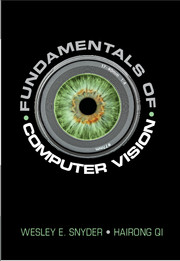Book contents
- Frontmatter
- Dedication
- Contents
- Preface
- For the Instructor
- Part I Preliminaries
- Part II Preprocessing
- 5 Kernel Operators
- 6 Noise Removal
- 7 Mathematical Morphology
- Part III Image Understanding
- Part IV The 2D Image in a 3D World
- A Support Vector Machines
- B How to Differentiate a Function Containing a Kernel Operator
- C The Image File System (IFS) Software
- Author Index
- Subject Index
- References
5 - Kernel Operators
from Part II - Preprocessing
Published online by Cambridge University Press: 25 October 2017
- Frontmatter
- Dedication
- Contents
- Preface
- For the Instructor
- Part I Preliminaries
- Part II Preprocessing
- 5 Kernel Operators
- 6 Noise Removal
- 7 Mathematical Morphology
- Part III Image Understanding
- Part IV The 2D Image in a 3D World
- A Support Vector Machines
- B How to Differentiate a Function Containing a Kernel Operator
- C The Image File System (IFS) Software
- Author Index
- Subject Index
- References
Summary
You need boundaries … Even in our material creations, boundaries mark the most beautiful of places, between the ocean and the shore, between the mountains and the plains, where the canyon meets the river
– Wm. Paul YoungIntroduction
In this chapter, linear operations on images are investigated. The derivative, probably the most common linear operator, is considered first. That discussion is extended into edge detection, the result of applying derivative kernels on images. A variety of methods for accomplishing this objective are considered.
• (Section 5.2)We first define what makes a linear operator and explain the kernel operator, or sum of products, which is the type of linear operator that will appear most frequently in this book.
• (Section 5.3) We show in this section how to use vector representation of images to convert kernel operators to the matrix multiplication form in order to facilitate some analytical study.
• (Section 5.4) We focus on the discussion of derivatives, since it is probably the most common kernel operator used in Computer Vision applications. We discuss how to find the derivative kernel operators through the definition of derivatives, by function fitting, using vector representation of images, and taking derivatives of special blurring kernels.
• (Section 5.5) Applying derivative operators on images would result in edge images. We describe in this section the different types of edges and a popular edge detector, the Canny edge detector.
• (Section 5.6) The concept of scale space is explained and how the scale space is associated with the detection of edges at different scales.
• (Section 5.7) In Chapter 1, we briefly described the biological vision. Here, we revisit this issue and ask the question how human beings perform lower-level vision, i.e., edge detection. We introduce the Gabor filter, which is believed to well characterize the functionality of receptive fields in the visual cortex.
• (Section 5.8) We wrap up this chapter by performing an experimental study on the various types of derivative kernels in terms of their ability in detecting edges (both angle and magnitude) of different orientations.
Information
- Type
- Chapter
- Information
- Fundamentals of Computer Vision , pp. 51 - 91Publisher: Cambridge University PressPrint publication year: 2017
